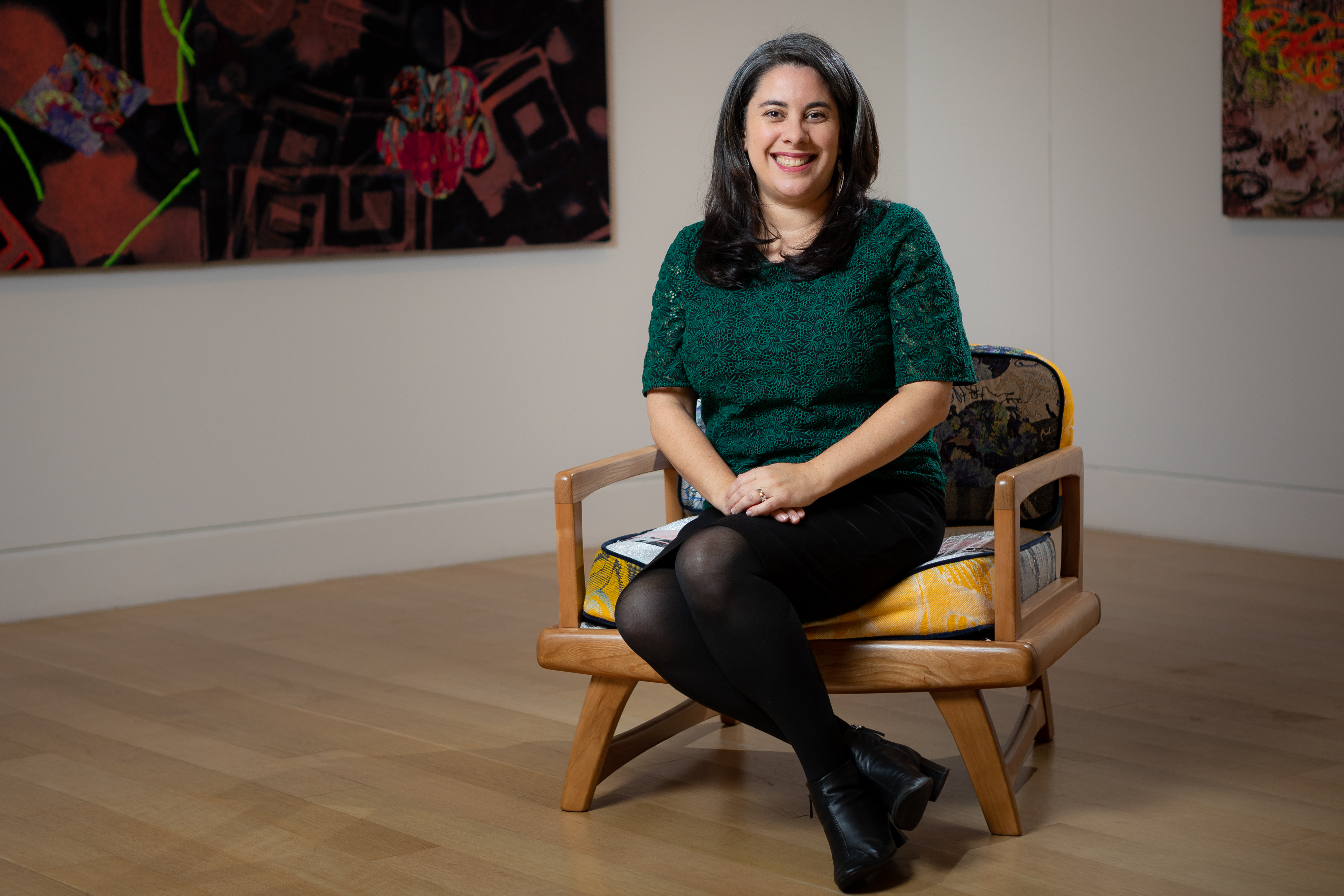 Julie Rodrigues Widholm, director and chief curator of DePaul Art Museum, has worked since her arrival in 2015 to amplify and integrate the museum’s mission into the larger context of the university, with a goal of providing exhibition space to new and underserved artists, including women, artists of color and LGBTQ artists. Here, she sits in a piece of art woven and dyed by artist Melissa Leandro, on display at DePaul Art Museum through Feb. 23. (DePaul University/Jeff Carrion)
Julie Rodrigues Widholm, director and chief curator of DePaul Art Museum, has worked since her arrival in 2015 to amplify and integrate the museum’s mission into the larger context of the university, with a goal of providing exhibition space to new and underserved artists, including women, artists of color and LGBTQ artists. Here, she sits in a piece of art woven and dyed by artist Melissa Leandro, on display at DePaul Art Museum through Feb. 23. (DePaul University/Jeff Carrion)
Julie Rodrigues Widholm first visited DePaul Art Museum in 2011 as a patron and left impressed by its exhibitions featuring contemporary art by Chicago-based artists. Four years later, she walked through the doors again as the museum’s director and chief curator. Since her arrival, she’s worked to amplify and integrate the museum’s mission into the larger context of the university, with a goal of providing exhibition space to new and underserved artists, including women, artists of color and LGBTQ artists.
“I want DePaul Art Museum to be a fearless leader of museum practice in the 21st century by providing artists who are not given equal opportunities a place to show the wide range of human experience. The museum strives to be an accessible institution and a place for intellectual curiosity and learning about each other through art,” Widholm says.
Since arriving at DePaul, Widholm has been recognized in New City’s Art 50 Visual Vanguard three times, and most recently was selected as the
2019 Chicagoan of the Year in museums by The Chicago Tribune.
In this Q&A, Widholm discusses problematic practices in the museum industry, how DePaul Art Museum addresses those issues, the museum’s new Latinx initiative and more.
What are some problematic practices in museums today when it comes to exhibitions?
Over the course of my career, I’ve observed an inequitable distribution of resources and opportunities within museum exhibitions. The foundation of museums traces back to Western European colonial structures, and the inequity has carried into the modern day. Male artists receive larger exhibition budgets and a larger space to exhibit their work, while female artists typically have smaller exhibitions and smaller budgets. For example, a 2018 study of 18 major U.S. art museums published by PLOS One found 85 percent of artists in their collections are white and 87 percent are men. In another study of 820,000 exhibitions across the public and commercial sectors in 2018 by The Art Newspaper, only one-third were by women artists, despite another study discovering women earn 51 percent of the Master of Fine Arts degrees conferred. I think we are starting to see a shift, but it’s going to take time and a lot of work.
What does DePaul Art Museum do to address these kinds of issues?
It requires mindful thinking about whom we’re giving space to in our exhibitions, public programs and permanent collections in an effort to be agents of change in the system. Our decision-making focuses on equity and reflecting our communities, and the city of Chicago. We also feel a responsibility to collect certain kinds of artists so they won’t be forgotten and, even better, will be the subjects of study for future students, scholars and art historians. Changing the landscape and providing opportunities for Chicago-based artists is how we address the issue of equity.
Why do you think contemporary art is a good channel for discussing complex and sensitive issues like colonialism, or environmental, racial and historical issues?
To me, contemporary art is a carrier of messages and meaning. Art also is a mode of human expression - anything a human experiences can be communicated through art. Moreover, art is about life and serves as a commentary on the artist’s view of the world in a given moment in time and place. Visual arts in museum spaces are a unique opportunity for people to encounter the unfamiliar and negotiate their experience with the unknown. This creates meaning for the viewer and helps people learn how to think about what is important to them and how their life experiences inform their understanding of the exhibition.
Are there any new initiatives DPAM is working on?
Our Latinx initiative is a three-year, multi-faceted focus of our energies and intentions to bring more visibility to U.S.-based Latinx artists. As such, it is a collection-building effort to add pieces by Latinx artists to our permanent collection and a community-building effort by partnering with organizations and units both on and off campus to help us improve our efforts. Our initiative takes on added importance given the previously mentioned 2018 study found that Hispanic and Latinx artists constituted only 2.8 percent of the collections of 18 major U.S. art museums.
For DePaul, it’s about student opportunities. Our Arthur James fellowship grants one student the opportunity to work with us to research the pieces in our collection and collaborate with us on exhibitions. More work has been done to bring visibility to Latin-American work, but not enough has been done for U.S.-based Latinx artists. They’re out there, but they’re not being shown in great numbers, so this is a necessary endeavor for us to undertake and we will try to contribute in any way possible. We aim to explore the complexity and diversity of Latinx communities to bring these issues to the forefront of our cultural conversations. We anticipate releasing more information about this initiative in the coming month.